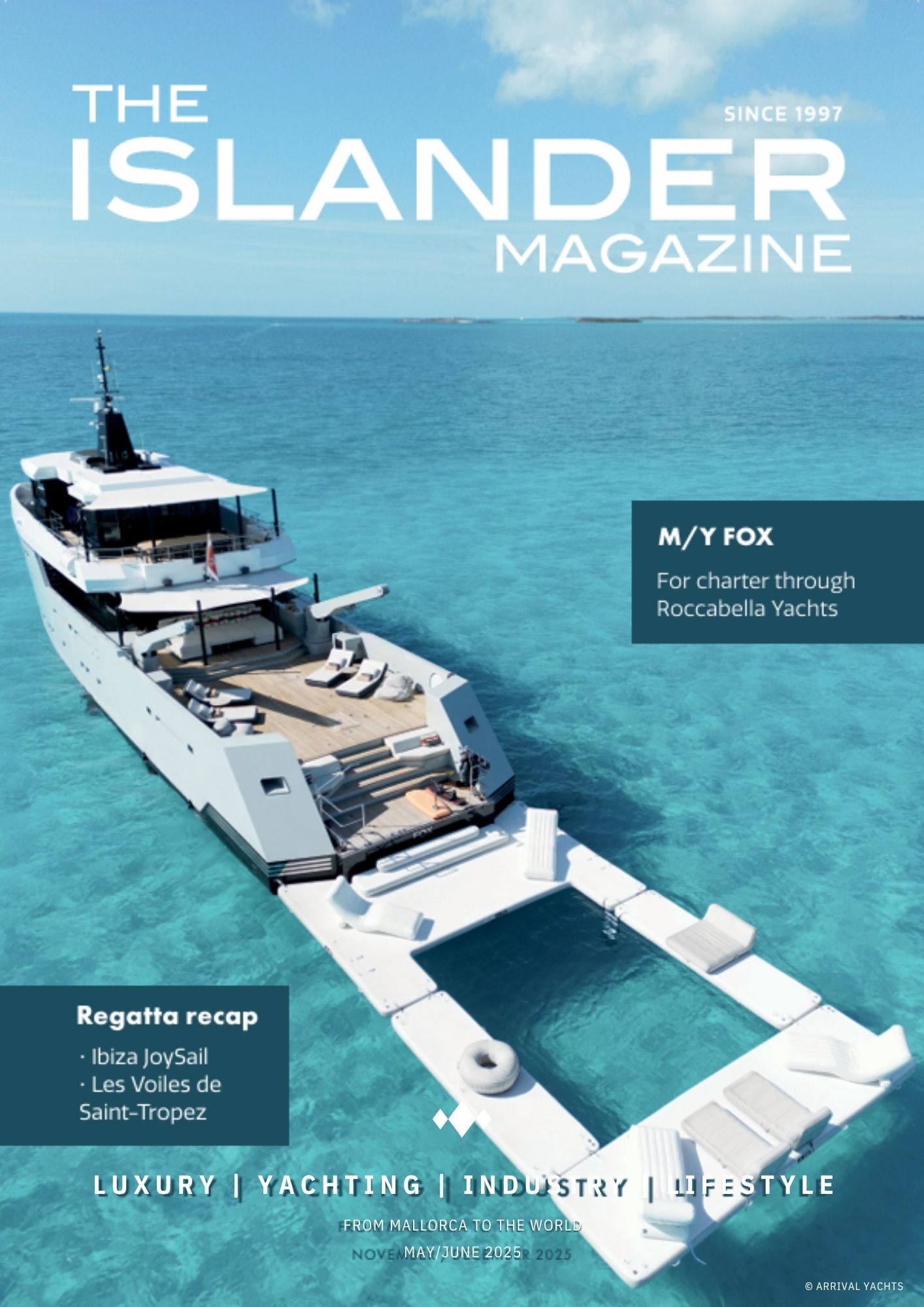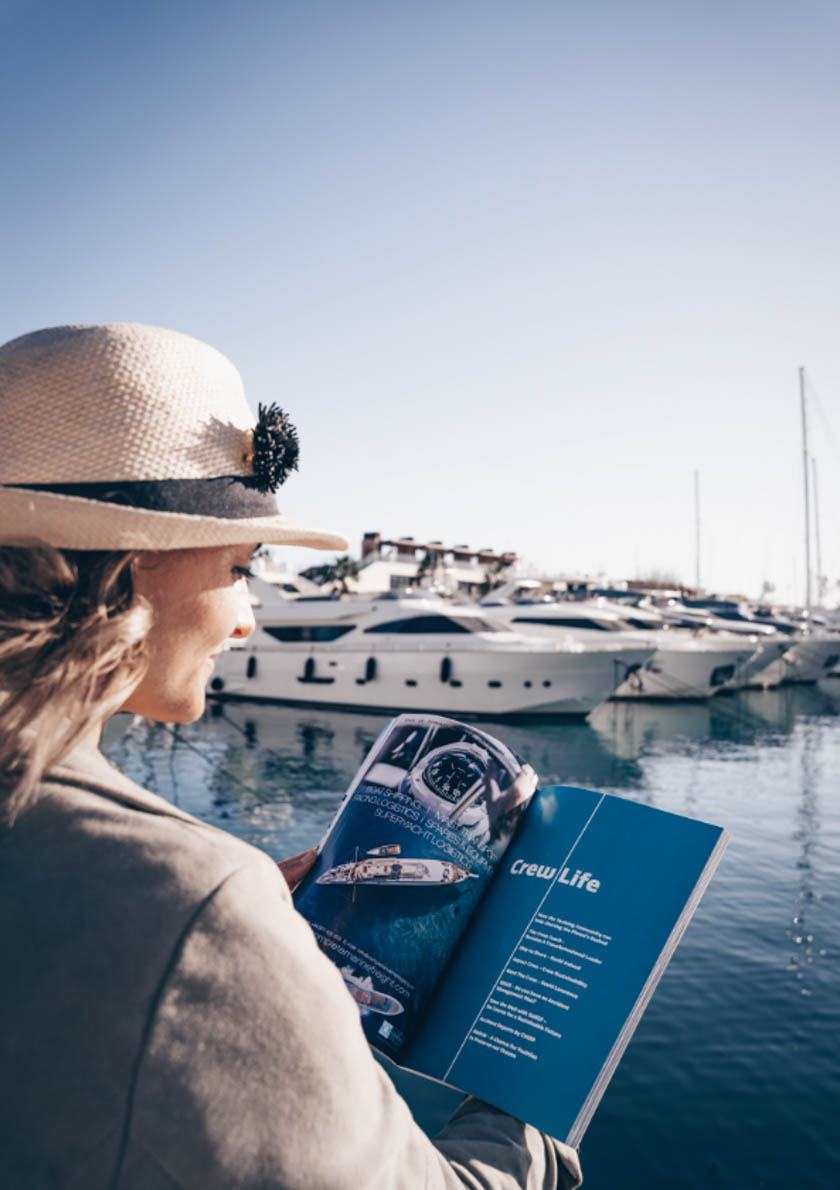The Present
The names Astilleros and STP Shipyard Palma are, for most of our readership, synonymous with Refit and Repair. The two have very distinctly different business models, but this allows them to cater for the different wants and needs of owners and Captains. Some prefer to micro-manage the refits and have specific contractors who they have probably used year after year. If this is the case then STP Shipyard Palma’s concept as the only fully open yard in the Balearics is probably the preferred choice. It is worth noting that it is possible to hire a project manager to oversee the whole project
However, some Captains or owners would just prefer one main contractor, who is solely responsible and offers a full guarantee, to coordinate what can be a very complicated refit season, with many different moving parts. In which case then Astilleros, with their centralised management yard approach is the perfect option. It is interesting to note that 85% of the works carried out are completed by outside contractors, who can be chosen by the client. They are then assigned a project manager to oversee all the work done by their own work force of trusted and approved craftsmen and women, in the prestigious yard. Having these two very different approaches is excellent for the Balearics as it extends it’s offering to the highly lucrative yachting sector.
Whilst these yards are buzz words that you hear over and again when hanging out with those in the industry, do many of our readers know their origins?
The Past
We’ll start with Astilleros, the elder of the two behemoths.
The origins of the company go back to 1942 when it was known as Astilleros de Palma, and was located in the “La Pedrera” area of the Paseo Maritimo, closer to the middle of the harbour. In those days the main activity of the business was commercial shipbuilding, mainly from wood and later in steel, as well as general repair work. The typical boats found on their slips were the Mallorquin Pailebotes as well as a fleet of boats for the Spanish Navy who at that time had a base in Porto Pi.
During the late 1950’s and early 1960’s the traffic on the Paseo Maritimo was increasing dramatically in line with the increase in tourism, and the shipyard’s activity was limited as access to the sea from the shipyard was via a swing bridge. This meant frequent hold ups for traffic each time a boat was launched! This was one of the factors which led to the relocation to the current site.
This move allowed Astilleros to modernise its business methods, and the President of the business at that time, Javier de la Rosa, chose a young naval architect from a modern shipyard in Seville, Rafael Garcia Rosello to join the company. His first major task was to amalgamate Astilleros de Palma with two other yards who already occupied the new location, Naviera Mallorquina and Astilleros Ballester, becoming Astilleros de Mallorca. He had been able to recognise Palma’s need of having proper construction and repair facilities and was instrumental in the creation of the Club de Mar Marina, which was modelled on the fashionable Cote D’Azur.
This heralded the start of the shipyard’s big involvement in ships up to 113 mtrs in length, and included the building of fishing boats, container ships, ferries, and LPG tankers, in addition to the normal business from the building of Snipe dinghies upwards. Orders for many different types of vessels were received from Mexico, Cuba, the Philippines, Argentina, Algeria, Tunisia, Portugal and of course Spain.
In 1974, Naviera Sevilla ordered the construction of four container ships. Three were delivered successfully, Suecia, Noruega and Dinamarca, but the fourth one ran into financial difficulties as the buyer ran out of money. This presented a big problem to the shipyard but thankfully through Royal intervention the fourth ship was saved as well as the future of the yard. The government decided to make the ship into a hospital ship for Spanish fishermen in the Canary Islands where many Spanish boats were based and was named “ Esperanza del Mar”. She became the first hospital ship ever built for the Spanish Social Institute and sailed for over 20 years. She experienced 74,950 calls to assistance, saved 3414 boats and rescued 1720 people from the water whilst covering an astonishing 1,467,225 miles in her 24 years of service.
The late 1970’s saw the first order for a leisure Motor Yacht, a 40 mtr Camper and Nicholson project. This was a very large custom yacht at the time, and based on the success of this project and the global growth of the large yacht market, the yard won the contract to build a 60 mtr 3 masted topsail schooner sailing yacht for a famous Argentinian broker, Carlos Perdomo. She was intended to be christened by the name “Argentina” upon launch and sail under a British flag, but due to the Falklands War she was finally named “Jessica” after Carlos’ wife, Norma Jessica .
The final tally of new built boats at Astilleros de Mallorca from 1942 onwards reached 241 by the time the final craft was launched in 1994. The final vessel was “Aldonza” a 32 mtr De Vries Motor Yacht which was on show at the 2014 Palma Superyacht Show!
The Mid 80’s saw a huge crisis in the shipyard industry all over Europe, with a fall from 50% of the world’s naval construction to just 20%, with much of the work moving to S E Asia.

1984 was the year when many big changes were made, and a decision to concentrate on repair and refit rather than building. At this time, there were just two boats on the order book, Jessica and Aldonza. Diego had decided that this was the way to improve the business and the long process of recovery began.
The current owners of Astilleros are Jesus Freire and Fernando Santodomingo who are related to a Spanish shipyard founded in 1895 in Vigo. Their main activity is the construction, transformation and repair of steel vessels of up to 155 mtrs. Apart from their long standing history, the Freire shipyard is well known for being the constructors of the famous MY Pegaso, a 74 metre exploration and oceanographic research Motor Yacht, recently renamed Naia .
In 1989, Diego was appointed as technical director to the Spanish America’s Cup team “Desafio”. When the campaign ended in 1992, he returned to Astilleros to become General Director, with one goal in mind, the final conversion of the shipyard towards the Superyacht Industry.
By then the staff numbers had been reduced by 50%, but the shipyard could survive according to the management, and they initiated the new era of repair and refit, especially to the up and coming Superyacht and classic yacht Industry. The restoration of classics started with the complete refit of Creole, the largest wooden sailing yacht ever built, now owned by the Gucci family. The success of this project was just a glimpse of what lay ahead for the business.
Hispania was another major milestone in the company’s history, with a complete restoration in 2004. This historical yacht was originally built for King Alfonso Xlll in 1909, to a William Fife 15 mtr Class design. This precious yacht carries the sail number ESP 1, and is a treasured part of Spain’s maritime history. The yacht now regularly competes in many Mediterranean Classic regattas with several other 15mtrs including her sister ship “Tuiga”, which is owned by the Yacht Club de Monaco.

Astilleros’ in house facilities are comprehensive and can haul up to 1700 tons on their slip and up to 70 mtrs in length , as well as having an exterior berthing quay for 110 mtrs. Despite this, and considering the limited amount of space, Astilleros employed 352 companies with 1787 workers in the auxiliary industry last year . In 2009 they decided to open a second office in neighbouring STP, with two fully equipped mechanical and metal workshops, with state of the art machinery. As a result, the project managers can provide their clients with a more flexible response inside STP’s yard.
Astilleros de Mallorca belongs to the ICOMIA Refit Group, where the leading refit shipyards in Europe are improving the professional working standards and environmental best practices
share standards
The collaboration with the Balearic University and Professional Engineering Schools is another goal in order to improve future generations of professionals.
Astilleros de Mallorca is now one of the most respected businesses in the Superyacht industry and Diego Colon one of its most revered men. They somehow seem to represent all that is good both for the industry and for Mallorca.
Turning now to STP Shipyard Palma. On 2nd December 2006, the Balearic Port Authority granted STP Shipyard Palma the licence to run the facilities located on Moll Vell, thus authorising its plans to upgrade the technical area. Major redevelopment and restructuring works took place over two years to adapt the space to the new services that the company wanted to offer. To do this, huge investment was made into both the facilities and the infrastructure, as well as the workforce.
With the arrival of STP Shipyard Palma, a 2.0 version was created of what had been a shipyard until then. Not only did it create a new business model within the nautical sector, but since its opening, growth and demand has been so great that it became an opportunity for industrial and technological development for professionals in the Balearics. This favoured the conversion or reinvention of many of them into experts in the sector and, thanks to this, the industrial fabric of Mallorca has achieved high international prestige.
“In that year – says José Maria Campuzano, CEO of IPM Group – the Moll Vell offered 50,000 m2 of hardstanding and berthing, a hoist-out capacity of 150 tons, moorings for yachts up to 50 metres and dry dock facilities for boats under 35 metres. What’s more, the area was relatively well-developed and with a huge untapped potential”.
Campuzano was a key player in the team that overhauled a facility that would ultimately have a huge impact on the refit industry, and therefore the yachting industry, in the Balearic Islands. “The situation has changed significantly and has evolved into a very competitive business model with greater refit opportunities, which all came to fruition in 2008 with the completion of the works”.
In that year, they accomplished a 50,000 m2 extension of the refit area, thereby creating a total of 105,000 m2, divided between a hardstanding of 70,000m2 and a water surface of 35,000 m2. The hoist-out capacity increased from just one 150-ton travel lift to six travel lifts, now with a capacity of up to 1,000 tons with the incorporation last year of the largest travel lift in Europe, a factor that has generated not only a considerable improvement in productivity and timings, but also the ability to evolve the customer profile that it currently repairs in the Balearic Islands.
They doubled the in-berth repair capacity, from 50 m to 100 m. All this created the ground-breaking ‘open shipyard’ concept, offering customers the chance to choose the companies they want to carry out their refit works with. Currently STP can repair up to 140 yachts at the same time with more than 1,000 boats going through the shipyard annually.

All these improvements triggered a substantial change in the quality and quantity of works offered by the yard itself and the local refit and repair industry, as this activity generated a significant increase in the contracting of such services, as well as a huge boost to related auxiliary industries. What’s more, it created a whole new market – made up of crews and workers – in Mallorca for complementary services, such as accommodation, bars and restaurants, laundry, car hire, and so on”.
An important thing to remember is that the bigger the yacht, the greater the needs it has, and the redevelopment of the STP facilities started to attract increasingly larger boats to Palma.
At the same time, the local marinas seized the opportunity to accommodate these new yachts arriving in Palma for refit works, hence the redevelopment and extension of berths to keep up with demand. All this goes to show that STP Shipyard Palma has had a major impact on the development of the yachting industry in general, and not just in the field of refit and repair.
Thanks to the improvements at the yard, there was an increase in the demand from yachts to undergo refit and repair works at STP, which translates into some astounding figures:
- 121% increase in refit and repair companies, from 210 in 2008 to 465 at the present.
- 200% increase in workers and professionals, from approximately 1,000 in 2008 to over 3,000 today.
- 75% increase in the day-to-day space occupied, from 12,000 m2 to 21,000 m2
- For every 100 m2 of new refit and repair space, 20 new jobs are created and 3.2 companies register at the yard.
These are some seriously impactful numbers and are key to continuing the growth of the sector within the Balearics.
But what impact do these two world-renowned shipyards have on the future of superyacht refit and repair here in Mallorca?
The Future
Earlier this year the Balearic Marine Cluster commissioned a report through the Superyacht Agency. The main objective of this report was to understand what the superyacht market thinks about the infrastructure and proposition of the Balearic region. The findings will be used to shape and deliver the programme for The Balearic Superyacht Forum, a unique and interactive event that will explore the value proposition of the islands from an operational, berthing, refit and service perspective.
To do so, BMC collaborated with The Superyacht Agency who have collated quantitative and qualitative data from a broad spectrum of the decision-making chain, including the market’s most influential stakeholders, who have shared their candid opinion of the Balearics. This comprises a dynamic online and interactive survey process with quantitative questionnaires and qualitative interviews, with a wide network of target customers, both existing and potential, to find out what they really think, about their experiences and what they would like to see change.
The findings are used to establish why a yacht would or would not consider visiting the region, and how this varies in the context of different stakeholders and yacht types. Based on the analysis and evaluation of both quantitative and qualitative data sets, the insights comprise the following:
The Balearic region is already a well-established key superyacht hub that has a reputation for varied cruising and quality infrastructure, but it is felt that it should further invest in cleaner and sustainable development, particularly for the 60m-plus market. There is also a strong perception that there is limited capacity and that the facilities could be modernised, and this could be deterring clients from considering the region as a refit destination”
When asked about their perception of the Balearics as a key hub for superyachts, in open-ended comments many respondents referenced its convenient location and its quality service and refit offering, as well as extensive cruising options as the primary characteristics that ensure its status.
The other most mentioned reasons were: yachting services, good anchorages, safety, connectivity with European capitals and crew downtime.
95% of those surveyed consider the refit offering of the Balearics to be “excellent” or “good”.
Mallorca also offers a year-round proposition in terms of cruising, yachting events, refit & repair infrastructure and popular options for long-term berthing.
The report highlights that yachts and the yachting market, in general, are not utilising the Balearics to their full extent. When they were asked how the Balearics could attract more yachts, the common comments were:
- less bureaucracy and a simpler regulation for charter license
- lower prices for berthing, more berths available
- more mooring buoys in the busy, protected anchorages
- improving the infrastructure for larger yachts, lack of dockage and haul-out facilities for yachts over 80m
- extending the season starting earlier by April and continuing until November when conditions return to normal after the pandemic.
- Another important issue evaluated was the consideration of which types of superyacht are the most valuable to a region; while all superyachts have significant operational expenditure, some have a greater impact than others. Charter yachts and yachts over 60 metres, for example, have a much bigger operational expenditure than private yachts and yachts under 60 metres and so have a greater economic impact
When analysing the number of yachts present in the Balearics on a month-by-month basis, it’s apparent that the most popular months are July, August and September. As April, May, June and October also offer good weather in the Balearics, yet have significantly lower numbers of visiting yachts, this perhaps indicates that there is much room for growth during these months. It’s understandable that the period between December and March is the least popular because this is when yachts are most likely to seek winter sun in the Caribbean or elsewhere.
The average length of stay in the Balearics has increased significantly in all size sectors, with the 30-40m sector seeing the highest increase, from 29.6 days in 2015 to 74.7 days in 2018. This is very positive for the region as a longer length of stay reflects more satisfied clients.
The average number of yachts (+30m) visiting Balearics in the last year: 450 yachts
The average LOA: 50m.
Recently the VIII Nautical Congress organised by ANEN was held in Valencia, in which José María Campuzano, participated as a speaker in the debate about the situation of the Refit & Repair nautical industry in Spain. Campuzano explained his vision of the industrial nautical sector in Spain and specifically explained the various factors that make the Balearic Islands the best international destination for yacht repair.
As he points out, “The stars have come together so that a series of conditions meet and make Mallorca the perfect place for boat repair. An important point is its strategic location in the Mediterranean, in addition to the warm weather throughout the year, which favours repair works. The facilities that we have, which accommodate a large number of yachts simultaneously has made Mallorca become the epicentre of the nautical repair and maintenance industry of Europe. And there’s no doubt that the sheer size and impact of the yacht refit and repair industry on the Balearic GDP makes it a driving force of the economy. So, it’s clear that yacht refits can be defined as driving forces of the economy, because not only do superyachts undergoing works over a period of several months buy materials for the boat, but they also have crews that live on the island and spend money, thereby adding to Mallorca’s economy. What’s more, we should emphasise the knock-on effect of this industry, because each direct job in the yachting industry creates six jobs in other sub-sectors. And the subsequent gross value added (GVA) multiplies its direct effect by five”, Campuzano added.
Interesting times lie ahead for the superyacht shipyard sector, especially considering the new proposals for reimagining the areas that Astilleros, who have requested a change of location and space expansion, and STP who have put in a request for space expansion, now occupy. *
The plans include Astilleros moving to the space currently occupied by the Trans Med Ferries, with the current space being given back to the people as a green space, including open areas and a maritime museum. The move would see Astilleros add a synchro lift to its offering, enabling the hauling out of larger boats and meaning that it can compete with the likes of MB92 , La Ciotat and Genoa. It will also mean that they will now be able to cater for larger boats both in and out of the water. Meanwhile the new plan would see STP expand dramatically both on the hard and additional berths in the water. The plans, which will hopefully be approved soon will see Mallorca’s refit and repair offering dramatically increase, which in turn can only mean more jobs, money and income for the island. Something that will be sorely needed after the huge economic impact of the pandemic!!
*Both requests are not confirmed as they have not been approved yet by Port Authority.
By Victoria Pearce & Simon Relph

















0 Comments